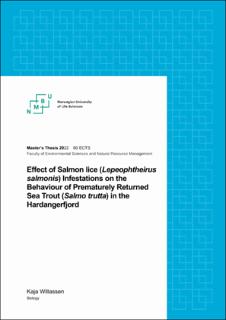| dc.contributor.advisor | Haugen, Thrond Oddvar | |
| dc.contributor.advisor | Urke, Henning André | |
| dc.contributor.author | Willassen, Kaja | |
| dc.coverage.spatial | Norway, Hordaland, Hardanger | en_US |
| dc.date.accessioned | 2022-09-26T10:02:08Z | |
| dc.date.available | 2022-09-26T10:02:08Z | |
| dc.date.issued | 2022 | |
| dc.identifier.uri | https://hdl.handle.net/11250/3021240 | |
| dc.description.abstract | The expansion of the salmon farming industry along the Northern coasts has caused a higher concentration of salmon lice (Lepeophtheirus salmonis) in the coastal waters and fjords. There has been observed that Sea trout (Salmo trutta) have adapted their behaviour as a response to the increased amount of salmon lice in the fjords. Sea trout infested with salmon lice from three rivers in the Hardangerfjord were captured and tagged with acoustic transmitters before being released back into the river again. The data that were retrieved and analysed were recordings from between mid-June to December 2021, from a total of 48 sea trout, where 40 were observed in the fjord. Results showed that the river most exposed to high salmon lice concentrations had the lowest proportion of migrants and that the probability of seaward migration decreased significantly with higher levels of salmon lice infestations. The time of river exit was found to be influenced by the water discharge in two of three study rivers, and the maximum distance travelled and the time they spent in the fjord after they had deloused was mainly influenced by individual characteristics such as length and weight. The depth use in the fjord was generally shallow with a mean depth of 1.16 meters across all rivers. The depth analysis showed several significant interaction effects, where the post-smolt performed small diel vertical migrations and that the depth increased slightly with higher chalimus density in two of the rivers.
When comparing the trout tagged with acoustic transmitters (AT) to trout tagged with passive integrated transponders (PIT), of PIT-tagged trout that were tagged at the same time as AT-tagged trout, 0 was identified as migratory individuals, while 63 % of the AT-tagged trout was observed in the fjord. Of all PIT-tagged trout, only 8 of 104 fulfilled the criteria for being defined as migratory. | en_US |
| dc.description.sponsorship | PO3 Kunnskapsinkubator ; Ministry of Education and Research | en_US |
| dc.language.iso | eng | en_US |
| dc.publisher | Norwegian University of Life Sciences, Ås | en_US |
| dc.rights | Attribution-NonCommercial-NoDerivatives 4.0 Internasjonal | * |
| dc.rights.uri | http://creativecommons.org/licenses/by-nc-nd/4.0/deed.no | * |
| dc.subject | Hardangerfjorden | en_US |
| dc.subject | Salmon lice | en_US |
| dc.subject | Lepeophtheirus salmonis | en_US |
| dc.subject | Sea trout | en_US |
| dc.subject | Salmo trutta | en_US |
| dc.subject | Lakselus | en_US |
| dc.subject | Ørret | en_US |
| dc.subject | Sjøørret | en_US |
| dc.title | Effect of salmon lice (Lepeophtheirus salmonis) infestations on the behaviour of prematurely returned sea trout (Salmo trutta) in the Hardangerfjord | en_US |
| dc.type | Master thesis | en_US |
| dc.relation.project | Salmon Tracking 2030: SALT2030 | en_US |
| dc.description.localcode | M-BIOL | en_US |

